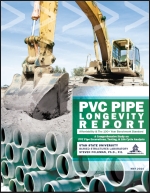| |
|
May 29, 2014
|
New Study: US and International Dig-Ups Confirm PVC Water Pipe Longevity in
Excess of 100 Years
 Utah
State University’s (USU) Buried Structures Laboratory has published a
comprehensive study on PVC pipe excavations, testing and life cycle analysis.
USU, located in Logan, Utah is also home to the Utah Water Research Laboratory
and has significantly contributed to water and wastewater research
internationally for over 50 years.
Click here
for report. Utah
State University’s (USU) Buried Structures Laboratory has published a
comprehensive study on PVC pipe excavations, testing and life cycle analysis.
USU, located in Logan, Utah is also home to the Utah Water Research Laboratory
and has significantly contributed to water and wastewater research
internationally for over 50 years.
Click here
for report.
The study reviews past dig-up reports and presents new quality control testing
results that continue to validate the performance and longevity of PVC pipe used
in water networks. A combination of pipe examination and testing data in
conjunction with previous pipe break studies support PVC as a sustainable pipe
material and confirm its longevity in excess of 100 years.
Improved Affordability for Ratepayers
“Understanding the longevity of pipes improves the ability
of a water utility to make better infrastructure investment decisions with
improved affordability results for customers,” says report author Dr. Steven
Folkman. |
| |
|
A previous USU study on water
main breaks in the US and Canada showed PVC pipe to have
the lowest rate of main breaks of all pipe materials
examined, which included ductile iron, cast iron, steel,
concrete, and asbestos cement.
Click here for report.
The new study continues to explore PVC reliability and
longevity. As well, the critical issue of affordability is
examined, which could not come at a better time as the US
water sector faces the difficult task of renewing its
buried infrastructure.
 According
to the US Conference of Mayors (USCM), a total of $2.28
trillion is needed in water and wastewater piping over the
next 20 years. “This study provides the next body of
evidence supporting the ability of utilities to address
the failing infrastructure and the affordability dilemma,”
says Folkman. According
to the US Conference of Mayors (USCM), a total of $2.28
trillion is needed in water and wastewater piping over the
next 20 years. “This study provides the next body of
evidence supporting the ability of utilities to address
the failing infrastructure and the affordability dilemma,”
says Folkman.
A major finding of the dig-up study is that US water
utilities can reduce water main breaks and operations and
maintenance costs by including corrosion-proof PVC piping
in their replacement programs. Earlier research by USU
showed that corrosion of iron piping is a major problem
for water systems and newer metallic pipes are
experiencing failures more rapidly than older types
because of their thinner walls.
The report also found that PVC pipes offer a high degree
of resilience in freezing conditions. This would help
reduce the ever increasing number of iron pipes that fail
during winter across the US annually.
Utilities Must Consider Corrosion Mitigation and Higher
Costs of Ductile Iron Pipe |
| |
|
The study discusses water pipe cost estimates for a city
in North Carolina replacing two water lines. The price
quotes for 1,600 feet of eight-inch pipe came in at
$29,588 for PVC pipe and $42,352 for ductile iron pipe.
And the quote for 1,500 feet of six-inch pipe came in at
$20,125 for PVC pipe and $40,110 for iron. However, the
purpose here is to illustrate the need for utilities to
include not only the initial cost of pipe (which is an
important cost consideration) but also operations and
maintenance, corrosion-control activities, etc. for all
pipe materials. Comparing the entire life cycle cost of a
pipe over a 100 year period is key.
A cost comparison methodology for water pipes developed in
a procurement report by the USCM is referenced as a useful
tool.
Click here for the Pipe Materials and Corrosion
Cost Comparison Worksheet. “Including the realistic
costs of corrosion control mitigation for ductile iron
pipes over the 100 year period for all pipe sizes is
critical in developing a comparable evaluation of PVC pipe
costs and ductile iron pipe costs,” concludes the report.
Click here to view the full USCM procurement
report on the cost-effectiveness of open bidding practices
for water and sewer piping.
Elected Officials, Financial Managers and Utility
Professionals Must Work Together
“Many utilities have fallen short in producing appropriate
cost and life cycle comparisons of pipe performance. Data
on water pipe longevity must be combined with asset
management techniques to make water and sewer
infrastructure more durable and affordable. As well,
elected officials, financial managers and utility
professionals must work together to create a new
management paradigm for water and wastewater systems,”
argues Folkman.
“The big take away is when you run the numbers to decide
what is the best investment, one of the critical
considerations is how long will this pipe last,” said Dr.
Folkman in an interview in Plastics News. “If it’s
done right, you should be able to base that on 100 years
for PVC pipe.”
 Dr.
Steven Folkman is a registered Professional Engineer, a
member of the American Society for Testing and Materials
(ASTM) F17 Plastic Piping Systems, a member of AWWA and
the Transportation Research Board Committee on Culverts
and Hydraulic Structures, and has oversight of the
prestigious Utah State University’s Buried Structures
Laboratory, which has been involved in analysis and
testing of all types of pipe and associated buried
structures for over 50 years. Dr. Folkman’s expertise
includes structural dynamics, linear and nonlinear finite
element analysis utilizing soil/structure interaction, and
testing. Dr.
Steven Folkman is a registered Professional Engineer, a
member of the American Society for Testing and Materials
(ASTM) F17 Plastic Piping Systems, a member of AWWA and
the Transportation Research Board Committee on Culverts
and Hydraulic Structures, and has oversight of the
prestigious Utah State University’s Buried Structures
Laboratory, which has been involved in analysis and
testing of all types of pipe and associated buried
structures for over 50 years. Dr. Folkman’s expertise
includes structural dynamics, linear and nonlinear finite
element analysis utilizing soil/structure interaction, and
testing.
Regards,
Bruce Hollands
Executive
Director | Uni-Bell PVC Pipe Association
2711 LBJ Freeway, Suite
1000 | Dallas, TX 75234
T. 972.243.3902 ext. 1019 | F.
972.243.3907
www.uni-bell.org
  
|
|
|
|
|
| |
 |
|
|